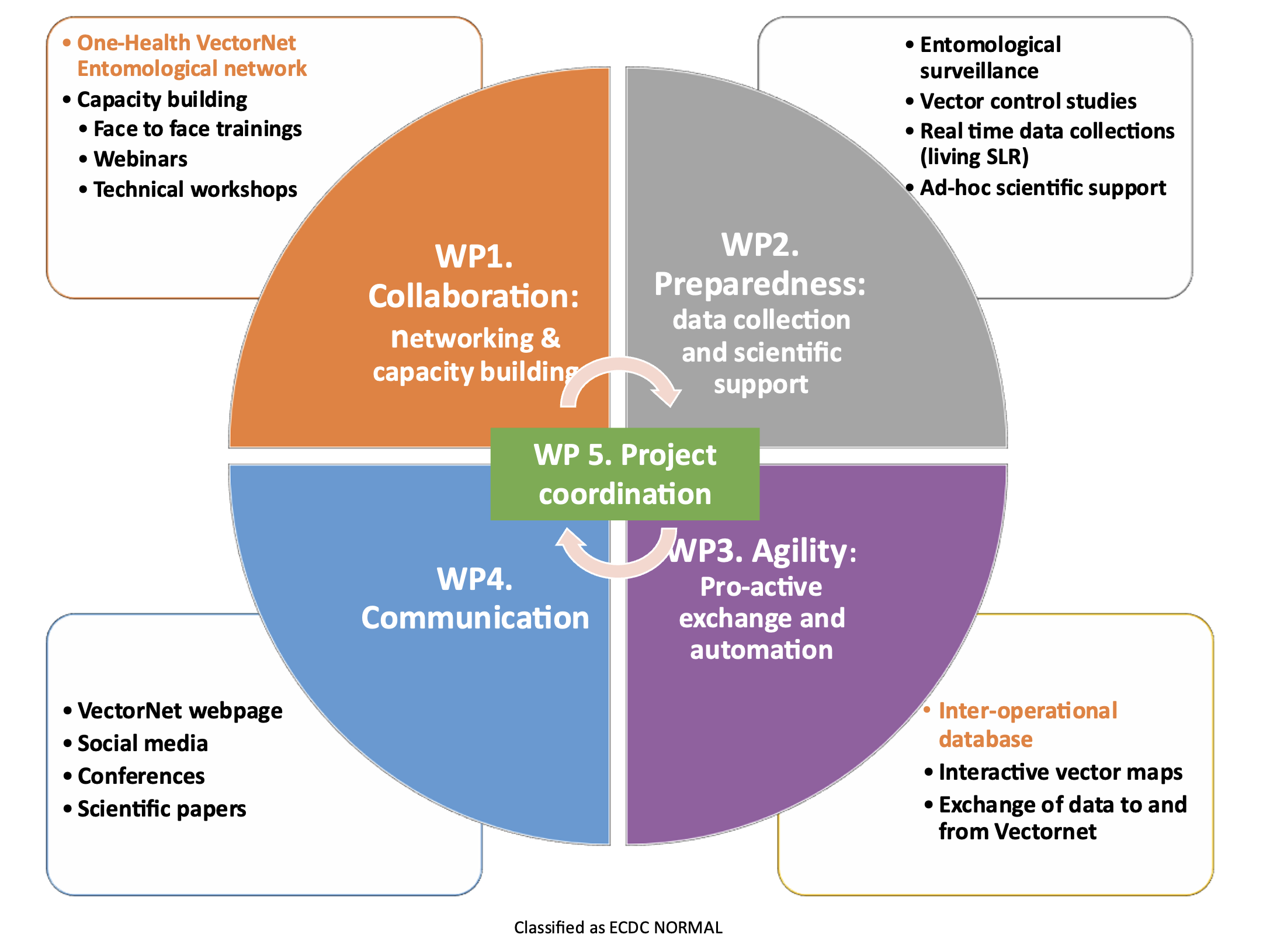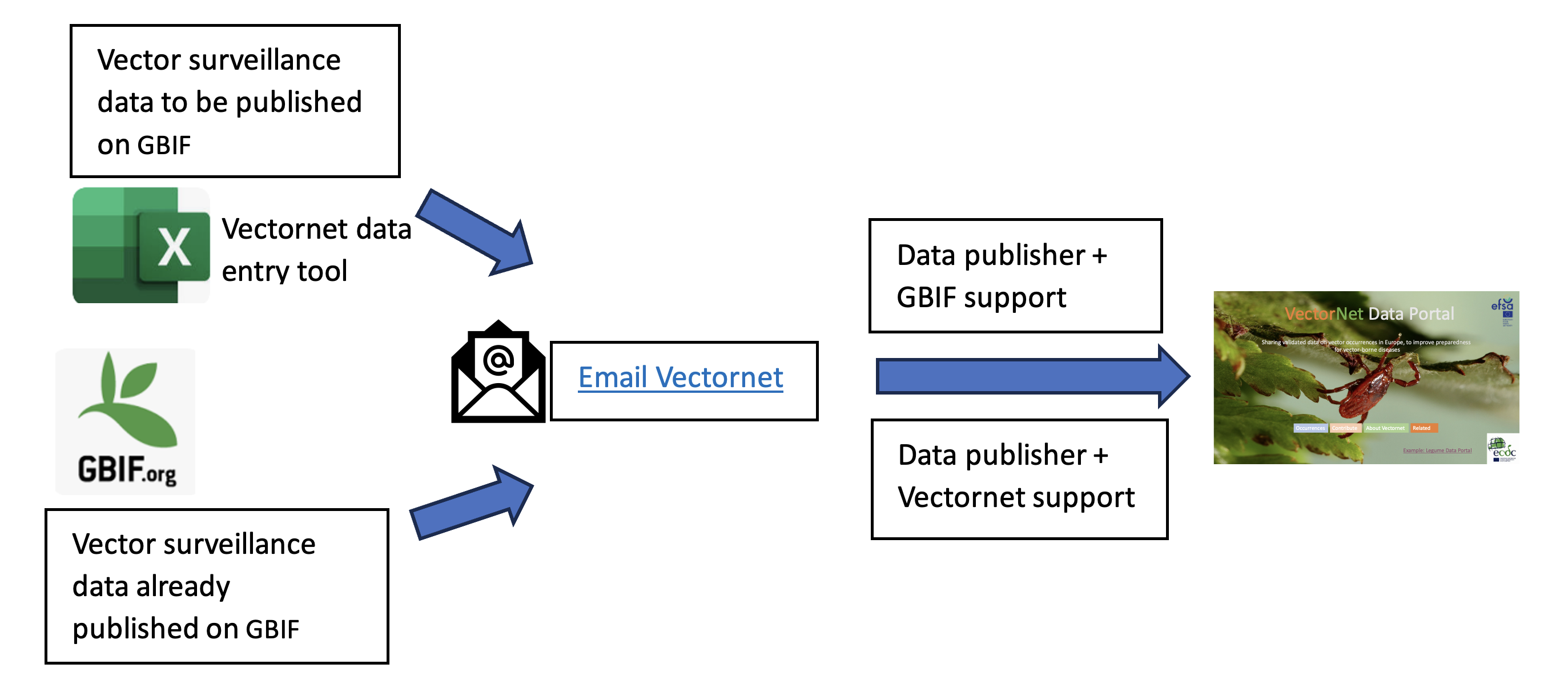About VectorNet
VectorNet is a project of the European Centre for Disease Control (ECDC) and the European Food Safety Authority (EFSA) which aims to contribute to improving preparedness and response for vector-borne diseases, following a ‘One-Health’ approach. The VectorNet consortium brings together a network of medical entomologists and public health professionals, together with veterinary entomologists and veterinarians working the field of vector-borne disease in Europe and the countries surrounding the Mediterranean Basin. The project also provides ad-hoc scientific advice to support ECDC and EFSA with technical questions on vector surveillance and vector-borne disease in humans and animals.
VectorNet started in May 2014, and is now running its third iteration (2024–2029). VectorNet supports the collection of data on vectors and pathogens in vectors related to both animal and human health. The project is structured in 5 work packages, fostering Collaboration, Preparedness, Agility, Communication and Project coordination and management.

Vectornet maintains a common database on the presence and distribution of vectors and pathogens in vectors across Europe and the Mediterranean basin. The project is operated by a consortium including the following VectorNet experts. The vectornet database is uploaded periodically on the GBIF Vectornet Data portal.
The primary outputs of VectorNet have been, and continue to be, the Vector maps at www.ecdc.europa.eu/en/disease-vectors
There are also many more reports and tools produced by the VectorNet, many of these organized on the VectorNet website at www.ecdc.europa.eu/en/disease-vectors but others published by EFSA in their journals. A list of VectorNet experts appear below:
VectorNet experts
| Expertise | Lead | Deputy |
|---|---|---|
| Mosquitoes | Alessandra della Torre | Francis Schaffner |
| Ticks | Annapaola Rizzoli | Kayleigh Hansford |
| Sand flies | Vít Dvořák | Bulent Alten |
| Culicoides | Thomas Balenghien | Maria Goffredo |
| Vector Control | Antonios Michaelakis | Francis Schaffner |
| Epidemiology | René Bødker | Veerle Vanlerberghe |
| Trials | Veerle Vanlerberghe | Wim Van Bortel |
| Data analysis | Kamil Erguler | Cedric Marsboom |
| SLR | Wim Van Bortel | Francesca Dagostin |
| Data manager | Tom Matheussen | William Wint |
| GIS | William Wint | Cedric Marsboom |
| Project management | Cedric Marsboom | Marieta Braks |
Contribute
Knowing the distribution of competent vector species is primordial for increased preparedness for vector borne diseases. To develop adequate prevention and control methods, it is of utmost importance that vector distribution data are reliable. The objective of the Vectornet Data Portal is to gather validated vector distribution data in the Vectornet Area (EU and neighbouring countries, including countries around the Mediterranean Basin), so they can be used by risk assessors and managers. All the data that will be pulled onto the Vectornet Data Portal will be first validated by one of the Vectornet experts, funded by ECDC and EFSA for the validation activities.
If you like to share your vector surveillance data to the Vectornet Data portal, contact biohaw@efsa.europa.eu, or you can publish your data with the help of one of the GBIF nodes in your area, if available, if your country is not part of the GBIF network, you can reach out at helpdesk@gbif.org or health@gbif.org.

The validation of entomological surveillance data will involve checking the following aspects of the vector surveillance:
1. Completeness check: to validate the data, a minimum of required data needs to be submitted, providing information about the location, the vector species, the collection method and the occurrence status. Information about the required variables is provided in the VectorNet GBIF data entry tool.
2. Check of the vector surveillance methodology: The validators will confirm that an appropriate trapping method was used for the targeted vector species.
3. Check of the vector identification: The validators will confirm that an appropriate identification method was used for the targeted vector species.
4. Upload the data in the GBIF test environment to highlight potential issues and automatically flag mistakes in the GBIF test environment.
5. Check for geographic distribution outliers: The validators will flag occurrences that were observed in areas with an inferred absence status for the specific vector.
Feedback of the validation check will be provided to the Data Providers. It will be the responsibility of the data providers to remove outliers and correct mistakes, before the data can be validated and published onto GBIF.
Related networks
Climate change and changing ecological conditions, as well as trade and travel, influence the spread of arthropod vectors, creating favourable conditions for the vector-borne diseases in previously unaffected areas. Since the presence of competent vectors is a prerequisite for the transmission of strictly vector-borne diseases, knowledge about their distribution is of primordial importance for their prevention and control.
After eight years of intense collaboration on VBDs, through two consecutive inter-institutional framework contracts, ECDC and EFSA joined forces to support a third iteration of VectorNet.
Besides the well-known vector distribution maps and capacity building in the EU Member States on vector surveillance, one of the strongest pillars of Vectornet is the fostering One-Health Vectornet Entomological Network (OHVEN). The OHVEN is composed of ECDCs Operational Contact Points (OCPs) for entomology and EFSAs Network on Veterinary Entomology (NVE).
The OCPs are nominated by ECDC National Coordinators and represent the entomologists working in the public health sector to combat VBDs. The NVE members are appointed by EFSA and represent entomologists working in the veterinary health sector.
The OHVEN network works closely together with the Animal Health and Welfare network of EFSA, and more in particular, with the sub-group on One health surveillance. Vector surveillance data collected byt the One health surveillance subgroup in the EU member states are also validated by Vectornet and uploaded on the GBIF Vectornet Data portal.
Further details of AHW network: Risk Assessment in Animal Health and Welfare (AHAW) network and its subgroups


